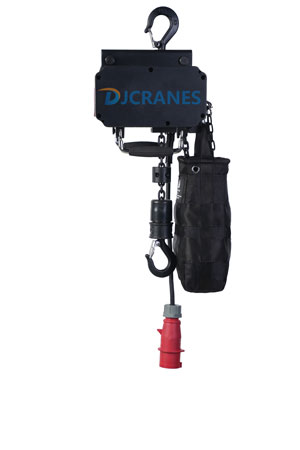Stage hoist - Maintenance Manual
Stage hoists are the core tools for hoisting stage equipment, used for safely lifting and lowering lighting fixtures, curtains, sound systems and other equipment. To ensure safe operation and extend service life, the following usage and maintenance norms must be strictly followed.
Stage Hoist Precautions for Use
Installation and commissioning
Installation location: Ensure that the stage hoist is installed on a stable support structure (such as trusses, I-beams), and check the load-bearing capacity of the tracks or lifting points.
Chain inspection: The chain must be hung vertically and must not be twisted or knotted. Before the first use, it needs to be run without load for 3 to 5 times to confirm that the chain is smooth and free of jamming.
Electrical connection: The power supply voltage must comply with the rated voltage of the hoist (commonly 220V/380V/400V/415V/440V and so on). Before use, check if the cables and plugs are damaged to avoid the risk of short circuits.
Stage hoist operating specifications
Load limit: Overloading is strictly prohibited (the rated load is usually 0.5T to 3T, for specific details, please refer to the equipment nameplate). The lifted objects need to be balanced to avoid uneven loading that could cause uneven force on the chain.
Operation control: During operation, maintain smooth takeoff and landing. Rapid direction switching is prohibited. The buttons on the remote control/control panel should be clearly marked to prevent misoperation.
Environmental requirements: Avoid using in damp, high-temperature (>45℃) or flammable and explosive environments. When used outdoors, it should be protected from rain and dust (with a protection level of IP54 or above).
Stage Hoist Daily Maintenance
Chain lubrication: Apply special chain lubricating oil (such as ISO VG 100) every month to prevent rust and wear.
Motor inspection: Regularly listen for the motor's operating sound. Abnormal noise may indicate bearing or gear faults.
Limit switch test: Test the upper and lower limit functions weekly to ensure reliable automatic stop.
Common Faults and Maintenance Guide of Stage Hoists
1. The stage hoist can not be started.
Possible reasons | Solution method |
The power supply is not connected | Check whether the sockets, circuit breakers and cable connections are normal. |
Control circuit failure | Test the signal of the remote control/control panel and replace the damaged parts. |
The thermal protector is triggered | The thermal protector is triggered Wait for the motor to cool down (about 15 minutes) and then restart it. |
2. The chain is stuck or makes abnormal noises.
Possible reasons | Solution method |
The chain is short of oil or rusty | Clean and lubricate the chain. Replace it if it is severely rusted. |
Gearbox wear | Disassemble and inspect the gearbox, and replace the damaged gears (professional maintenance required) |
Track deformation/offset
| Adjust the levelness of the track to ensure that the chain runs vertically. |
3. The motor is overheating.
Possible reasons | Solution method |
Frequent starts and stops or overloading operation | Reduce the operation frequency and use strictly in accordance with the rated load. |
Failure of the cooling fan | Clean the dust from the fan or replace the damaged fan. |
Unstable voltage | Install a voltage stabilizer to ensure that the voltage is within ±10%. |
4. The limit switch has failed.
Possible reasons | Solution method |
The limit switch has failed
| Manual reset: Check whether the mechanical structure of the limit switch is stuck and clear the obstacles. |
The limit switch has failed
| Electrical testing: Measure the on-off state of the switch with a multimeter. If it is damaged, replace it with a limiter of the same model. |
Regular maintenance plan for stage hoists
Cycle | Maintenance content |
Daily | Inspect the appearance of the chain and cable, and test the emergency stop function. |
Every month | Lubricate the chain and clean the motor's heat dissipation holes. |
Every half a year | Thoroughly disassemble and inspect the gearbox and replace the worn parts. |
Every year | Entrust professional institutions to conduct load tests and safety certifications. |
Safety Warnings for Stage Hoists
No carrying: Stage hoists are only for lifting equipment. It is strictly forbidden to lift people!
Emergency: Press the emergency stop button immediately to cut off the power supply before troubleshooting.
Professional maintenance: When disassembling circuits or gearboxes, it must be carried out by certified electricians or technicians.
Note: There may be detailed differences among stage hoists of different brands. Please refer to the manufacturer's manual for accuracy. If the problem can not be solved by yourself, please contact after-sales service!
As for Dejun brand stage hoist, any questions or need any support, contact us freely, our team always here.
- The last one:What's difference between forged crane wheels and cast crane wheels?
- The next one:No information!
 info@dejunindustry.com
info@dejunindustry.com +86 13721448067
+86 13721448067






